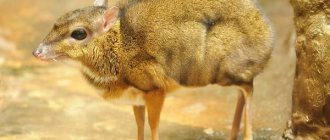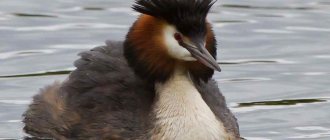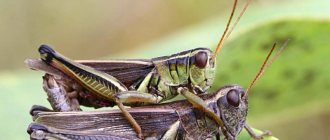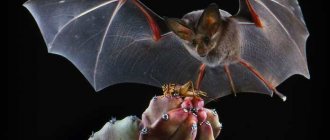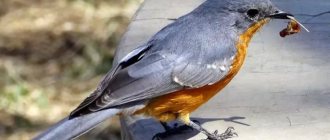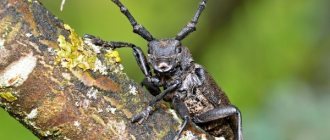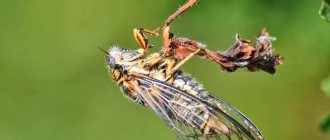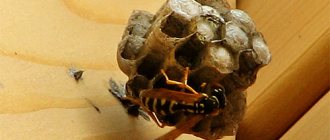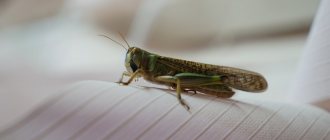Appearance and features
Photo: Shrew on the site
Despite the fact that there are a considerable number of varieties of shrews, and they all have their own specific features, there are still common characteristics of appearance inherent in the shrew family. In relation to the body, the animal’s head is quite large, the muzzle is elongated and pointed, and the nose turns into a small proboscis that is mobile.
The animal's paws are short and have five toes. The fur cover is thick and velvety. The length of the tail varies among different species; in some it is very short, in others it is longer than the entire body. The skull has a narrow and elongated shape, which is pointed closer to the nose. A unique feature of the shrew is the size of its brain; it is one tenth of the weight of the entire animal, which is much larger than that of humans and dolphins.
As such, there are no cheekbones in shrews, and the number of teeth varies from 26 to 32. Permanent teeth replace milk teeth at the embryonic stage, so newborn shrews are born with teeth. The longer incisors are located in front, especially the lower ones. Around the anal and genital openings there is something like a roll of leather. On the sides at the base of the tail there are glands that emit a specific foul odor.
The shrew has a very fast heartbeat, at rest it is up to 700 beats per minute, and in a state of fear it can reach up to 1200 beats. In general, scientists have noticed that these creatures are very unbalanced and nervous, so they can die even from a loud thunderclap.
Behavior
The shrew is an ardent supporter of hermitism. She does not tolerate the presence of other individuals in her home area. When she meets a fellow tribesman, she makes frightening sounds and tries with all her might to immediately drive him away. If this does not help, he boldly attacks the uninvited guest.
Throughout the day, the shrew shows increased activity. Due to her intense metabolism, she has to constantly be in search of profit. The animal tirelessly searches for food in the top layer of the earth and in the leaf litter. He is helped in hunting by his superbly developed hearing and sense of smell.
The diet includes worms, arachnids, insects and their larvae. Sometimes a shrew can attack small rodents, pick up carrion or the remains of its fellow tribesmen. The thrifty animal hides the leftover food in order to eat it later. Sometimes, in search of food, he can climb a tree.
The animal deftly moves under a layer of fallen leaves or grass, forming real compacted tunnels.
The active animals do not go into hibernation even in the most severe frosts. In winter, they live under the snow, trampling branched paths under it. During snowless winters, shrews run along the surface and collect seeds of bushes and trees. During this period, they significantly decrease in size and weight. All the internal organs of the animal become smaller, including even the bones of the skull along with the brain located in it.
If necessary, the shrew can swim, although it prefers to avoid any bodies of water in every possible way. In self-defense, she desperately defends herself. On the sides of her body and near the base of her tail there are glands that, in moments of danger, release a secretion with a very pungent and pungent odor.
Thanks to him, many species of predators do not touch shrews. The only exception is owls, who find them very tasty and aromatic.
SEVERE! SINGLE MOTHER
Shrews do not form pairs; they live alone; cubs from different males can be born in the same brood. During the summer, the female brings one or two litters of 4-6 naked, blind cubs. For about three weeks, the babies stay in the nest, where the female feeds them milk, then for a few more days they run after the mother in a “caravan”, when the first cub clings to the mother with its teeth, the second cub - to the first, and so on. Then the brood breaks up, the mother expels the cubs from her territory, and they go looking for free places. When passing through occupied territories, shrews behave cautiously. If the animals collide with each other, you can hear their sharp, rasping voice.
Common types of shrews
Body length 55-82 mm, weight from 4 to 16 g. Tail 60-75 mm long. The body is dark brown on top, almost black-brown, the abdomen is light. The young are light brown. The tail is bare or slightly pubescent. The ears are almost invisible. The muzzle is narrow, elongated.
The species is distributed in northern Europe in dense grassy thickets, forest undergrowth, bush thickets, and heather heaths.
Tiny shrew or Chersky's shrew (Sorex minutissimus)
The smallest species with a body length of 4-5 cm, a tail length of 2.5-3 cm. Weight is about 4 g. The head is wide and large, ending with a short proboscis. The eyes and ears are small. The fur is short, velvety, dark brown or brown on the back and gray or silvery-white on the belly. The tail is also dark above and light below.
The species is found in the west from the Scandinavian Peninsula to Japan and Sakhalin in the east.
Tibetan shrew (Sorex thibetanus)
The body length is 51-64 mm, the tail is 32-54 mm long. Outwardly similar to an ordinary shrew.
The species was discovered in China, in the provinces of Qinghai, Sichuan and Gansu.
Bukhara shrew (Sorex buchariensis)
Body length 55-69 mm. The tail is 42-50 mm long with a tassel at the tip. The back is painted sandy brown or light brown. The belly is light gray. The head is elongated and narrow.
The species' habitat includes Uzbekistan, Tajikistan, and Kyrgyzstan, where it lives in high-mountain birch and poplar forests.
Medium shrew (Sorex caecutiens)
Body length is from 58 to 77 mm, tail length is 36-42 mm, weight is 4-8.5 g. The back and sides are brown to dark gray, the belly is grayish-white.
Body length 62-64 mm, tail 38-43 mm long. The back is grayish-brown, the belly is reddish-fawn. The tail is dark brown above, light below.
A rare species that lives in the south of the Chinese province of Gansu.
Large-toothed shrew or dark-toothed shrew or dark-toothed shrew or dark-toothed shrew or large-toothed shrew (Sorex daphaenodon)
Body length is 61-71 mm, weight reaches 9.5 g. The proboscis is short. The back is dark brown or black, the sides are light, and the belly is dark gray. The tail is brown.
Distributed from the Urals to Sakhalin.
Giant shrew (Sorex mirabilis)
One of the largest species with a body length of up to 10 cm and a weight of about 14 g. The body is brownish-brown in color, the belly is lighter and dull. Muzzle with long light gray whiskers.
Endemic to the Far East, where it lives in the south of the Primorsky Territory, northeast China and the north of the Korean Peninsula. Listed in the Red Book of Russia.
Equal-toothed shrew (Sorex isodon)
Body size is average. The fur color is dark, monochromatic, the fifth upper intermediate tooth is brightly pigmented.
Body length is about 41 mm, tail length up to 33 mm. Summer fur is long, fluffy, silky. The tail is pubescent with a tassel at the tip. The back is chocolate-brown in color, the sides are light, the belly is white with a fawn coating.
A rare species, was discovered in Tibet.
Little shrew or small shrew or little shrew (Sorex minutus)
Body length 43-64 mm, tail length 31-46 mm. Weight from 2.5 to 7.5 g. The back is brown-gray or reddish-coffee. The belly is grayish-white, rarely yellowish-fawn. Winter fur is darker. The hair on the tail is thick and long. The proboscis is sharp, elongated.
Distributed in Europe, the European part of Russia, in the west and south of Siberia, in Kyrgyzstan.
Clawed shrew (Sorex unguiculatus)
Outwardly it resembles a common shrew. Body weight reaches 20 g, body length 54-97 mm, tail length 40-53 mm.
Body length is about 57 mm, tail 54 mm long. Weight about 5 g. The back is earthy-gray, the sides are light, brown or fawn. The belly is light gray. The hind foot is very elongated.
The species is distributed in the northeast of Siberia, in Kamchatka.
Masked shrew (Sorex cinereus)
The body length reaches 9 cm, including 4 cm of tail length, weight up to 5 g. The fur is gray-brown on top, light gray below, the muzzle is pointed. The tail is brown above, lighter below, and the tip is dark.
Found in Canada and the USA.
Long-tailed shrew (Sorex dispar)
The medium-sized shrew is gray in color with a light belly, a pointed muzzle and a long tail.
It lives in North America, in the forests of Canada and the USA.
Little shrew (Sorex hoyi)
Body length is up to 5 cm, tail is about 2 cm, weight is 2-2.5 g. The fur is gray-brown or red-brown, the belly is light. In winter, the fur turns gray.
Outwardly it resembles an ordinary shrew.
It is endemic to Paramushir Island (Kuril Islands).
Marsh shrew or water shrew (Sorex palustris)
Red Book and population
The population of different shrew species and its size varies significantly. For example, for Eurasia, the most common (and, accordingly, numerous) is the common shrew with a population of about 600 individuals per hectare. Naturally, the more food and places suitable for living are available, the greater the distribution density of the species. The small and tiny shrew and many other species have approximately the same habitat. Many American shrews are also characterized by densely populated habitats, which cover mainly forest and tundra zones.
There are also clearly localized species of this family - for example, the Caucasian shrew, which lives in the forests of the Caucasus, or the Kamchatka shrew, which lives on the coast of the Sea of Okhotsk and Kamchatka.
In this family, it is not so common to find very small or rare (especially if we are talking about a limited territory) species - although each country can boast of its rarity.
For example, only one species of shrew is listed in the Red Book of our country - the giant shrew. This rodent is indeed the largest representative of its genus and is classified as a rare species that is characterized by low numbers. The giant shrew lives in the forests of Primorye and is found in only a few places in this territory: the Lazovsky Nature Reserve, the Kedrovaya Pyad Nature Reserve, and Lake Khanka.
For the shrew and its protection, completely unoriginal measures are used, which mainly include the preservation of areas suitable for habitation. After all, it is important that even such a creature, which lives on the edge of the capabilities of warm-blooded animals, can survive.
Description of the shrew
The small animals are very similar in appearance to ordinary mice, but have an elongated muzzle in the form of a kind of proboscis. Shrews also include the smallest representatives of the class of mammals, represented by the dwarf shrew (Suncus etruscus) and the tiny shrew (Sorex minutissimus), whose body length does not exceed 30-50 mm, with a maximum body weight in the range of 3.0-3.3 gr.
Appearance
The shrew's head is quite large in size, with an elongated facial section and a nose elongated into a movable and clearly visible proboscis. The animal's eyes are quite small. The limbs of the insectivorous mammal are short and five-fingered. The fur is thick and short, very velvety. The tail can be very short or incredibly long, exceeding the length of the body.
This is interesting! Female shrews have 6-10 nipples, and the male's testes are located inside the body, while the copulatory organ of an adult animal is very large, accounting for up to 70% of the body length.
The skull is narrow and long, pointed in the nasal region. The brain part is expanded, which is a unique feature among mammals. The volume of the brain is a tenth of the body weight, which significantly exceeds the data typical for humans and dolphins. The zygomatic arches of shrews are completely absent, and the total number of teeth is 26-32.
The front incisors, especially the lower ones, are significantly enlarged. The replacement of baby teeth with permanent teeth occurs at the embryonic stage of development, so baby shrews are born with a full set of teeth. The anal and genital openings are surrounded by a skin cushion. On the sides of the body and at the root of the tail there are special glands that produce a secretion that has a pungent, unpleasant odor.
The heart of a shrew beats at rest at a speed of 680-700 beats, and when frightened, the heart rate increases to 1100-1200 beats. Representatives of the class Mammals, order Insectivores and family Shrews are very nervous. Absolutely any strong enough shock, including the sound of a thunderstorm or clap of thunder, can kill an insectivorous animal.
Lifestyle, behavior
Most species prefer damp places, and some representatives of this family are accustomed to leading a semi-aquatic lifestyle. Shrews are solitary and can dig burrows on their own or occupy the homes of other burrowing animals, including moles and some mouse-like rodents. Sometimes shrews can settle in voids inside stumps or fallen trees, under dead wood, and even in human buildings. The nest is lined with dry leaves and grass. Each animal has its own hunting area, the size of which often reaches tens of square meters.
This is interesting! Shrews left without food die very quickly. For example, small species can die in just 7-9 hours, and the small shrew - in about five hours.
Any species of shrews never hibernate, but in conditions of lack of food, so-called short-term torpor may well occur, accompanied by a noticeable decrease in body temperature. The short-tailed shrews that live in Canada and the United States and the common shrew that inhabit the shores of natural reservoirs in Russia are representatives of very few poisonous mammals. The poison affects even people, so the bitten area swells greatly.
How long do shrews live?
The life of shrews is very short. The maximum average lifespan of such representatives of the order Insectivores and the Shrew family is only one and a half years. Females live a month longer than males.
Sexual dimorphism
At the moment, shrews have been little studied, which is due to their predominantly nocturnal lifestyle and frequent stay underground. However, it has been established that there are no pronounced signs of sexual dimorphism in appearance among representatives of the order Insectivores and the Shrew family.
Shrew species
Today, about three hundred species of shrews are known, but the most common are the shrew and its subspecies, the shrew and its varieties, as well as elephant and water shrews. The tiny shrew is the smallest representative of mammals, and its body length does not exceed 30-50 mm. The animal owes its name to the brown enamel located on the tips of the teeth and protects them from grinding down too early. The shrew's fur also has a brown tint.
The dwarf shrew or shrew is a prominent representative of insectivores and is distinguished by the white color of its tooth enamel. Body dimensions do not exceed 70 mm. This animal is relatively rare and is characterized by a gray coat color. The largest representative of shrews is the giant shrew, reaching a body size of 15 cm with a tail length of 10 cm. The color of the shrew's coat varies from light gray shades to almost black.
Water shrews or common shrews are large insectivores that prefer to settle on the banks of natural fresh water bodies. A distinctive feature of the structure of these aquatic animals is the presence of hard hairs on their paws, which ensure efficient movement in the water. In addition, the mammal has a waterproof coat. In appearance, the animal resembles an ordinary water rat of a grayish color with a lighter shade in the abdomen.
Mouse-like shrews are active both during the daytime and at nightfall. The fur of such shrews is silky and very soft, and the color of the coat varies from yellowish-brown and gray to black. The body length is approximately 60-110 mm, with a weight of up to 21-23 g. American short-tailed shrews belong to a group of relatively large and poisonous shrews with a relatively short tail, thick legs and dark-colored fur.
Wood shrews are relatively small in size, and their body length, as a rule, is 45-100 mm, with a weight ranging from 3-12 g. The total length of the tail varies markedly. The animal has long and silky gray fur on the upper part of the body and a slightly lighter lower part.
The Ugandan armored shrew differs from other mammals in its unique skeletal structure. This genus was considered monotypic for a long time, but in 2013 the Tora shrew, which has the same features, was described. The body length of an adult is 12-15 cm, with a tail length of 7-10 cm and a body weight of 110 g. Coarse and thick wool has a characteristic gray color.
What does a shrew eat?
The diet of the common shrew consists of insects, slugs, spiders, worms, amphibians, and small rodents. To survive, they must consume 200 to 300% of their body weight daily.
To achieve this goal, eat every 2-3 hours. A shrew will starve if it goes without food for more than a few hours. They do not hibernate in winter because their bodies are too small to store sufficient fat reserves and have a short fasting period.
Animals have evolved amazing adaptations to survive winter. Their skulls are reduced by almost 20% and their brains are reduced by as much as 30%. Other organs also lose mass. Total body weight drops by approximately 18%. When spring comes, they grow until they reach their original size.
Scientists believe that the drop in temperature causes their bodies to break down bones, tissues and absorb them. As temperatures begin to rise with the arrival of spring, the body rebuilds lost bones and tissue. This process significantly reduces food requirements and increases the chances of survival in winter.
The shrew has poor eyesight. Instead, they use their superior senses of smell and hearing to find food.
Natural enemies of shrews
Many predators hunt shrews, but they do not always eat them, and often throw them away after being caught. This is due to the fact that the animal has specific glands that secrete a liquid with an unpleasant odor, which repels predators. The main natural enemy of the shrew is the owl.
Shrew: description
Shrews are not large in size and have an elongated muzzle and a long tail. The animal grows up to 5-10 cm in length, with a tail length of 3-7 cm. They can weigh from 3 to 15 grams.
The body of the shrew is covered with fine hair of dark shades. It is mainly brown-gray in color, with the animal’s abdomen having a light tint. The animal is so called because the tops of its teeth are brown-red. As you get older, the tops of your teeth become discolored as they wear away. The shrew's teeth have a clear division into molars, canines and incisors.
The animal's ears are small and barely noticeable behind the short fur. Vision is poorly developed, since the shrew spends almost its entire life underground. But she has a well-developed sense of smell and hearing, which allows her to find food for herself without any problems. Its presence can be determined by shallow paired tracks.
The animal protects itself from predators by releasing a strong musky aroma, as a result of which predators refuse such prey.
Shrews (1989)
Watch this video on YouTube
Lifestyle
The common shrew can live up to one and a half years. It begins to reproduce in the spring, with the arrival of the first spring warmth. Under roots or stumps they form nests in the form of a ball from the stems of various plants. The cubs are born about three weeks after fertilization, and already 20 days after that, they leave the nest. During the season she gives birth to babies up to 3 times. The first litter may consist of 10 animals, and the last of 4, but no more.
These animals are active all year round, since they practically do not sleep in winter. They spend most of their lives in underground tunnels. Despite the fact that shrews belong to the genus of shrews, they do not dig underground passages, but use ready-made ones left by other animals. In addition, they use natural cracks in the ground.
The shrew's diet includes everything that can be found underground: mole cricket larvae, May beetle larvae, worms, woodlice, etc. They often catch small lizards and frogs. Metabolism occurs very quickly, so a shrew can live only a few hours without food. During the day, she eats 2 times more food than she weighs. The smaller the animal, the more often it feeds, so the shrew eats about 70 times a day.
With the arrival of winter cold, the shrew switches to feeding on plant foods. In addition, her congenital processes begin to activate, which help the animal survive the winter. Before the real winter cold, the animal significantly loses weight and volume, but by the beginning of the breeding season, all processes in its body are normalized.
Benefits and harms of shrews
The shrew, especially in the warm season, feeds on animal food, giving preference to insects and their larvae. Therefore, we can consider it a useful mammal. In addition to insects harmful to the garden, the animal also destroys beneficial ones, such as earthworms and spiders.
The shrew is in constant motion, which is associated with the search for food. Therefore, she does not stand on ceremony with what gets in her way. Anything that prevents it from moving underground suffers from the teeth of this animal, and this can be garden plants. But this is not due to the fact that the shrew spoiled them in order to feed. If there is any trend towards the destruction of garden crops, then it is most likely not a shrew.
Causes and signs of appearance in the garden
It is almost impossible to predict the appearance of a shrew in a garden plot, since it spends most of its time underground. Most likely, it appears completely by accident, moving underground in search of food. This animal can be confused with a mouse or a mole, although the shrew itself does not dig tunnels, but moves along existing ones. It is quite difficult to detect this animal, and it is not such a frequent visitor to garden plots as a mouse, for example. Perhaps by chance this animal may appear, but in this short time it is unlikely to be identified.
Kinds
Researchers suggest that there are about 260 species of shrews living in nature. They are found in a variety of natural zones, adapting to the climate of the regions. They are not found only on the Australian continent and the North Pole. Twenty-one species have been recorded in Russia. Let's look at some of them:
- The pygmy shrew is a small animal of a gray-brown or smoky color with an elongated muzzle. Protruding (guard) small villi are noticeable on the tail. The size of the body does not exceed 3.5-4.5 cm. The teeth are sharp, the front incisors are large, and have a characteristic snow-white color. The species was popularly dubbed the Etruscan shrew and the polytoothed little one. Lives in mountainous regions of Europe.
The common shrew (wood shrew) is a common species of the shrew family. Found in the northern part of the European continent. Settles in grass and shrub thickets, forest undergrowth. But it can also live on private plots, causing damage to agricultural land. The body size is average - 5-7 cm, tail length 6-8 cm. The fur color is dark brown, the abdomen is light. The muzzle is extended forward. We talked more about shrews here, and read more about the types of shrews here.
The tiny shrew (Chersky's shrew) is the smallest mammal found in Russia and the smallest insectivore. Transpalearctic representative. The habitat extends from the Scandinavian Peninsula to the islands of Japan and Sakhalin. It is found in the Primorsky Territory, Oryol Region, on the borders with forest-tundra, and in Kazakhstan.
The house shrew (long-tailed shrew) is a large animal, reaching 6-7 cm in length. The color is brownish-gray. Distributed in Germany and Africa. In our country it is found in Siberia and the northern territories of Russia. Often settles in sheds, storerooms, barns and houses, causing damage to agricultural land.
Other types
- The little shrew (little shrew) is the smallest mammal in North America. Distributed in Canada and the USA. Settles in deciduous, coniferous forests and open places. The length of the body including the tail is 5 cm. The color of the fur is gray-brown.
The elephant shrew (leaphopper) is a small African mammal. It is distinguished by long hind legs and bright brown-red fur color. Due to its physiological characteristics, it can develop fast speed and jump over obstacles over 1 meter. Modern researchers attribute this mysterious animal to the order Afrotheria. In the literature it was classified as an insectivore and even a lagomorph. The subspecies consists of 16 individuals living on the African continent.
The water shrew (common shrew) is a large representative, reaching 11-12 cm in length, weighing 10-20 grams. The fur is thick, velvety black, and has the ability to not get wet in water. The muzzle is elongated. The tarsi have stiff bristles that increase the paddling surface and aid in swimming. The water shrew lives in Norway, France, Sakhalin, the Scandinavian Peninsula, and in Asia it is distributed from Northern Mongolia to China. May be found in Kazakhstan.
The giant shrew (house shrew) is an animal that lives in Africa, Asia, the Middle and Far East. He gained fame thanks to Chuchundra, a character in R. Kipling’s famous story Riki-Tikki-Tavi. A large representative, reaching 11-12 cm in length. The fur color is dark gray. Often settles among people, causing harm to agriculture.
You can read information about other harmful rodents that need to be combated in agriculture and in summer cottages here: Earth rat, Black and red rats, Wild hamster, Gophers, Moles, Wood mouse, Vole mouse, Gray mouse, Steppe pied, Yellow pied
External characteristics
There are many species in the shrew genus, more precisely, about 130. The differences between the animals lie in size and habitat. Well, some slight variations on the theme of color. A characteristic feature of the animal is its long body parts, namely the tail and muzzle.
Body length 5-10 cm, tail – 3-8 cm, weight 2.5-15 g. The fur cover is short-haired, from dark gray to brownish. The bellies of almost all species are light. The tail is slightly hairy, with short pile, except for the flat-skull variety, in which it is quite fluffy.
The tips of the animal's teeth are red-brown. This became the determining factor in the name. But with age, the tops of the teeth wear off, and nothing remains of the unusual color. The small ears on the head are almost invisible from under the fur. The beads of the tiny, round eyes are black. But in general, the shrew’s eyesight is weak (due to its underground existence), so the main organ in search of food becomes the nose, whose powerful sense of smell perfectly captures odors. The shrew is also quite good at echolocation.
Shrews of this species are one of the oldest creatures on the planet belonging to vertebrate mammals. Their jaws are clearly divided into canine, incisor, molar and anterior teeth. The shrew leaves behind a small chain of paired tracks. On the soft snow cover, a clearly defined path is visible from the tail.
Nature has rewarded the rodent with a bright musky smell. Therefore, even after catching an animal, many predators do not eat it.
Benefits and harms
Perhaps someone will consider the shrew to be a worthless animal, but in reality this is not the case. For humans, this animal can be very useful. Looking for food, shrews loosen the soil in gardens and vegetable gardens, which they do very well thanks to their unique trunk nose.
During the so-called “plowing” the soil is saturated with oxygen and at the same time cleared of harmful insects and larvae. But if you are used to seeing beautiful lawns, then, of course, the shrew will cause you a lot of trouble because of the constant minks that you will encounter on the site.
Shrews are incredibly useful creatures because they can reach many harmful insects in places that other insectivores and birds cannot reach. It is not difficult for them to find pests under stones, under snow and in the depths of burrows.
When you first meet these animals, they seem to be quite cute and fluffy creatures that are not capable of harming humans. However, if you try to catch this animal, they may bite, and the person may experience severe pain. Therefore, if you suddenly meet a shrew on your site, then forget about catching it or picking it up.
Character and lifestyle of the shrew
Unlike mouse , the shrew is an insectivorous mammal. In addition, she does not dig minks, but lives in the forest floor: the surface of the earth covered with fallen leaves and withered grass from last year.
In winter, the animal does not hibernate, so it can be found in an active state at all times of the year. The shrew is cautious, and its main life takes place at night. But it can carry out its activities at any other time of the day, especially becoming more active a few hours before sunset.
It is capable of making winding passages in soft soil, under snow and in loose forest floors, doing this with the help of its proboscis and paws. Sometimes he uses the moves of rodents for his advancement: moles, voles, mice.
The small shrew has poor eyesight. And the main organs that help her survive in this world are touch and smell. In addition, at night she is helped to navigate by such a special and unique device given to her by nature as echolocation.
This addition to other sensory organs, which distinguishes it from many other living beings, helps it not to get confused in the dark among the stems of grass and plant roots.
In search of what it is striving for, the shrew emits sound pulses. And the animal’s ears, which have a unique structure, receive in response the necessary signals, giving it the necessary information about the features of the surrounding world.
Notes
- Mammals. Large encyclopedic dictionary / scientific. ed. I. Ya. Pavlinov. - M.: ACT, 1999. - P. 36. - 416 p. — ISBN 5-237-03132-3.
- Sokolov V. E.
Five-language dictionary of animal names. Mammals. Latin, Russian, English, German, French. / under the general editorship of academician. V. E. Sokolova. - M.: Rus. lang., 1984. - P. 39. - 10,000 copies. - Hutterer, Rainer
. Soricomorpha. // Wilson, Don E., and Reeder, DeeAnn M. ed. Mammal Species of the World (3rd ed.). Baltimore: Johns Hopkins University Press, 2 vols. (2142 pp.). pp. 285-286. ISBN 978-0-8018-8221-0. OCLC 62265494. - Won, Byeong-o (원병오).
한국의 포유동물 (Hangugui poyudongmul, Mammals of Korea). - Seoul: Dongbang Media, 2004. - ISBN 89-8457-310-8. - Andrew T. Smith, Yan Xie (eds.)
A Guide to the Mammals of China. Princeton. 2008. 544 p. - ↑ Hutterer, Rainer
. Soricomorpha. // Wilson, Don E., and Reeder, DeeAnn M. ed. Mammal Species of the World (3rd ed.). Baltimore: Johns Hopkins University Press, 2 vols. (2142 pp.). pp. 285-286. ISBN 978-0-8018-8221-0. OCLC 62265494. - Sokolov V. E., Orlov V. N.,
Key to mammals of the Mongolian People's Republic M.: Science. 1980. 351 p. - A. Bekenov, P. M. Butovsky, B. B. Kasabekov and others.
Mammals of Kazakhstan. T. 4. Insectivores and bats. Alma-Ata: Science. 279 p.
Reproduction and lifespan
The breeding season for animals begins in early spring, usually in March, and ends in late autumn.
During this period, the mother shrew is capable of giving birth to several litters (from two to four), each of which adds 3-9 cubs to the number of this species of insectivore.
The animal's pregnancy lasts about three to four weeks. And by the end of the gestation period, shrews build a nest among the roots of trees or stones. They build a home for their future children from leaves and moss, covering it with something soft for convenience.
Small shrews develop quickly, although they are born completely blind and with an unprotected, naked body. Over the next three weeks, from the moment of birth, they feed on mother's milk.
After two weeks, the cubs' pupils open and they begin to become covered with fur. And after 3-4 months they are already able to bear offspring. The animals live for about 18-23 months, but during this time they are able to multiply greatly.
Commander's belt tooth
Shrews are a genus of mammals of the shrew subfamily of the shrew family. These small animals feed on insects, arachnids, earthworms, and small animals. Distributed in the temperate zone, in the forests and taiga of Europe, Asia and North America. There are about 70 species of shrews in total.
Shrew distribution
The shrew is found throughout Eurasia from the shores of the Pacific to the Atlantic Ocean, south to Palestine and to Siberia in the north.
— Advertising —
The animal lives in various areas, but always in damp and shady areas. Lives in forests, parks, meadows. In cold seasons, it enters populated areas and hides in storerooms and cellars.
Feeding features of shrews
Due to its very small body mass, the shrew has a very difficult time surviving in low temperatures. They need to consume a lot of food to maintain their body temperature, this is not so easy, they have to move around a lot in search of food.
There are 17 species of shrews in the fauna of Russia.
The shrew is always on the verge of life and death, because if it does not provide itself with food that exceeds its own weight at least three times, it dies of hunger in just a few hours. Because of this, this shrew is not picky about food; it happily eats insects and their larvae, earthworms, and if necessary, it can feast on its dead relatives.
In addition to living organisms, it also eats seeds of various coniferous plants, animal droppings, and all kinds of mushrooms. Sometimes it can climb up the bark of a tree to get into the clutch of a silkworm. Frogs are usually attacked in winter, when amphibians are hibernating.
The basis of nutrition is invertebrates (insects, arachnids, earthworms).
Nutrition
The animal, despite its modest size, is extremely voracious, consuming twice its weight in food per day.
And she finds food by actively rummaging in the upper layers of the soil, which has the misfortune of greatly annoying avid gardeners and gardeners. But it’s better not to rush to get angry at neighbors like shrews, because animals can help get rid of many pests: caterpillars, weevils, leaf beetles, click beetles, chafers, mole crickets, and slugs.
Moreover, a shrew rarely catches the eye of a person, because it operates mainly at night, actively swarming in the garbage. The animal feeds on terrestrial invertebrates: snails, centipedes, spiders and earthworms.
In the forest floor, teeming with small animals where it lives, it is not difficult for it to obtain food during favorable periods. The shrew is also quite capable of eating bird droppings, carrion and plant seeds, which usually make up its winter diet.
When eating, the animal usually rests on all four paws, but in some cases, for example, when eating slippery worms or beetles, it can use its front paws to hold its prey.
Often in search of something edible, the shrew climbs trees, climbing the trunk, clinging to uneven bark with its paws in order to feast on the eggs of a nun butterfly or gypsy moth.
To get food, the shrew is capable of attacking even such large animals, in comparison with its size, as small rodents and frogs. And if he wins, he eats them almost entirely, leaving only the skins and bones of his victims.
Many frogs become prey for shrews during hibernation, and when the snow melts, only their thoroughly gnawed skeletons can be found on the forest floor.
Shrew: habitat and diet
The animal, which has a surprising external resemblance to a field mouse, does not actually belong to the same class as it. The shrew is a vertebrate mammal, and the mouse is a rodent.
And upon closer examination, it is clearly visible that the shape of their muzzle is different: in the shrew, the front part turns into a clearly defined trunk-shaped nose.
But the color of the fur and the length of the tail are almost identical.
Habitat area
It's hard to believe, but these tiny creatures are predators. The smallest on Earth. The man even nicknamed the shrew “little devil”; its character is very aggressive and quarrelsome. The large shrew family consists of 300 species, but they are divided into two main categories (subfamilies):
The name is determined by the color of the large front incisors. In the first group they are snow-white, in the second they are brown. The main, that is, the most numerous include:
- Water cutter;
- The shrew is tiny;
- Giant shrew;
- Dwarf polytooth.
Shrews live almost all over the planet. There are only two places on Earth where they exist:
- Arctic Circle (which is very conditional, since although it is extremely rare, individual individuals can be met).
- Australia (which, in principle, is not very clear, because there are excellent conditions for the animal to live there).
“Russian” residents – shrews – number two dozen species. The most common one is the shrew. This is a small creature (3-18 cm). She has a dark coat with short and thick pile, sharp teeth, an elongated proboscis on an elongated muzzle.
The animal needs its proboscis to search for food; it uses it to loosen and dig up the soil. The shrew has special glands that secrete musk (a substance with a pungent odor), with which the rodent scares off enemies.
Due to its underground existence, the shrew has poor eyesight, but other senses are well developed: smell and touch. The animal does not fall into winter sleep and is active all year round. In summer it feeds on what it finds on the surface of the earth and in the forest floor; in winter it runs under the snow, digging out larvae and insects in the soil. It breeds 1-2 times a year, in a litter of 1-10 cubs. Lives 12-8 months.
Territorial boundaries
Shrews are terrestrial creatures. Even the water shrew, which is called the water shrew, actually lives in coastal burrows. The rest like to settle in dense forests and gardens, where there is always a lot of soft last year’s foliage.
They very rarely dig a home on their own, preferring to inhabit other people's houses. Animals especially love rotten tree trunks, where there is almost always a cozy hollow or crevice. They rarely appear on the surface during the day, preferring a twilight and nocturnal lifestyle.
The animal clearly marks its territorial boundaries (hunting grounds). Several shrews may coexist with each other in border areas, but the invisible barrier must not be violated
The abundance of food is very important for the animal and it does not intend to share its reserves with anyone
If the borders are violated, the “enemy” will face a brutal rebuff, up to and including the death of one of the parties. And the fight will be not only with a relative, but also with mice, lizards, etc. An intelligent animal does not completely exterminate all the insects on its site.
Having eaten a certain amount, the shrew moves to another area so that this one can replenish its population.
Diet
Digestion in shrews works quickly. This forces her to search for food constantly, with short breaks for sleep and rest.
The animal's gluttony is also explained by the fact that it needs to maintain a normal thermal temperature and have a reserve of energy (the shrew is warm-blooded and extremely mobile).
Without food, an animal will not live very long: 8 hours in winter, 2-3 in summer.
The food of a rodent depends on the season of the year:
In the summer these will be insects (worms, mole crickets, caterpillars, slugs, midges). When there is a lack of food or severe hunger, the shrew's predatory instincts awaken, and then it attacks mice or lizards. Representatives of aquatic species make their living by catching fish and frogs.
In the cold, cruel natural selection occurs; not everyone survives until spring.
What are the benefits and harms for humans?
In fact, animals provide a lot of useful things through their life activities. The trunk nose is an excellent soil loosener. The earth is saturated with oxygen, and the shrew rids it of harmful insects along with larvae. True, the habit of digging the ground will not appeal to owners of beautiful lawn designs.
Animals destroy not only pests not only in the soil, but also in their hiding places: under snow cover, stones, in burrows and crevices.
The shrew is a cute and cute animal, but you should not try to catch this fluffy creature with your bare hands. In defense, the animal will bite, and this is very unpleasant and painful.
What does a shrew look like: photo
Shrew.
Name: Shrews Lat.:
SorexClass: Mammals - Mammalia Order: Insectivores - Eulipotyphla or Lipotyphla Family: Shrews - Soricidae
| Habitats: | shaded areas of forests and steppes |
| What it eats: | small insects, bugs |
| Description: | carnivorous mammals that do more good than harm |
